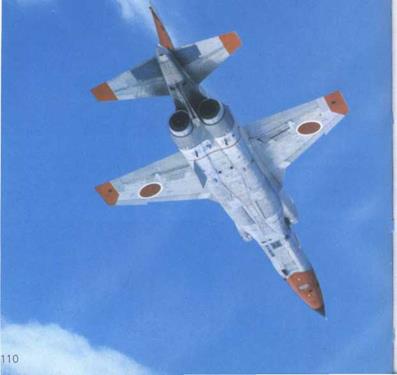Mitsubishi F-l and T-2
F-1 and T-2A
Origin: Mitsubishi Heavy Industries Ltd, Japan.
Type: (T-2A) two-seat supersonic trainer; (F-1) single-seat close-support fighter-bomber.
Engines: Two Ishikawajima-Harima TF40-801A (licence-built Rolls – Royce/Turbomeca Adour 102) two-shaft augmented turbofans with maximum rating of 7,1401b (3238kg): (F-1) may later have more powerful version.
Dimensions: Span 25ft 10in (7-87m); length 58ft 7in (17-86m): height (T-2) 14ft 7in (4 445m), (F-1) 14ft 9in.
Weights: Empty (T-2) 13,6681b (6200kg): (F-1) 14,3301b (6500kg): loaded (T-2, clean) 21,2741b (9650kg): (T-2 maximum) 24,7501b (11,200 kg): (F-1 maximum) 30,200lb (13,700kg).
Performance: Maximum speed (at clean gross weight) 1,056mph (1700km/h, Mach 1-6): initial climb 19,680ft (6000m)/min: service ceiling 50,025ft (15,250m): range (T-2 with external tanks) 1,785 miles (2870km): (F-1 with eight 500lb bombs) 700 miles (1126km).
Armament: One 20mm M-61 multi-barrel gun under left side of cockpit floor: pylon hardpoints under centreline and inboard and outboard on wings, with light stores attachments at tips. Total weapon load (T-2) normally
|
|
2,0001b (907kg); (FI) 6,0001b (2722kg) comprising 12,5001b bombs, eight 5001b plus two tanks of 18 3g a I, or two 1,3001b (590kg) ASM-1 anti-ship missiles, and four Sidewinders.
History: First flight (XT-2) 20 July 1971; (T-2A) January 1975; (FST-2) June 1975; service delivery (T-2A) March 1975; (F-1) 1977.
User: Japanese Air Self-Defence Force.
Development: Japan’s first post-war military aircraft was the Fuji T-1 tandem-seat intermediate trainer, looking like an F-86 Sabre and powered by a licence-built Bristol Orpheus.’First flown in 1958, 42 were delivered as the T-1 A, followed by 22 T-1 В with the Japanese J3 engine. To replace the T-1 and other trainers such as the T-33 a design team led by Dr Kenji Ikeda designed the I – 2. Japan’s first supersonic aircraft, using the Anglo – French Jaguar as a basis. After flight trials had shown the validity of the design a single-seat version, the FST-2-Kai, was ordered to replace the F-86 as a close-support fighter. By mid-1 975 orders had been placed for 46 T-2A trainers and the first 4th Air Wing unit had formed at Matsushima Air Base. The T-2A has proved efficient and popular in service, and is incidentally the first properly supersonic aircraft to be designed in Asia. Though a trainer, it carries Mitsubishi Electric radar, with air search, mapping, lock-on and ranging modes, as well as a J/AWG-11 (Thomson-CSF) HUD. Production is at the rate of two per month; by the start of 1 977 orders stood at the planned level of 59, to be completed in 1 980, and deliveries at 37. The first 18 FST-2 fighters (since redesignated F-1) had also been bought, with four flown in 1975. Total F-1 procurement is to be 68, all delivered by the end of 1 979. The F-1 has a Ferranti inertial nav/attack system and Mitsubishi Electric weapon-aiming computer, radar altimeter and radar homing and warning system, most of the added boxes being installed in the bay occupied by the rear cockpit in the T-2A. Production began in 1977, with the letter of intent for a force of 68, all to be delivered by March 1 980. Planned total is 110.
Left: From this angle only an expert could tell that this is not an F-1 but a dual T-2A trainer, 71 of which are to be used at the 4th Air Wing base at Matsushima. Of these, 31 are of the basic T-2 type, while the other 40 are T-2A combat trainers with internal ‘Gatling gun’ and various other changes. A further two aircraft were converted into prototypes of the F-1 single-seat combat aircraft, 36 of which had been delivered by 1980.











